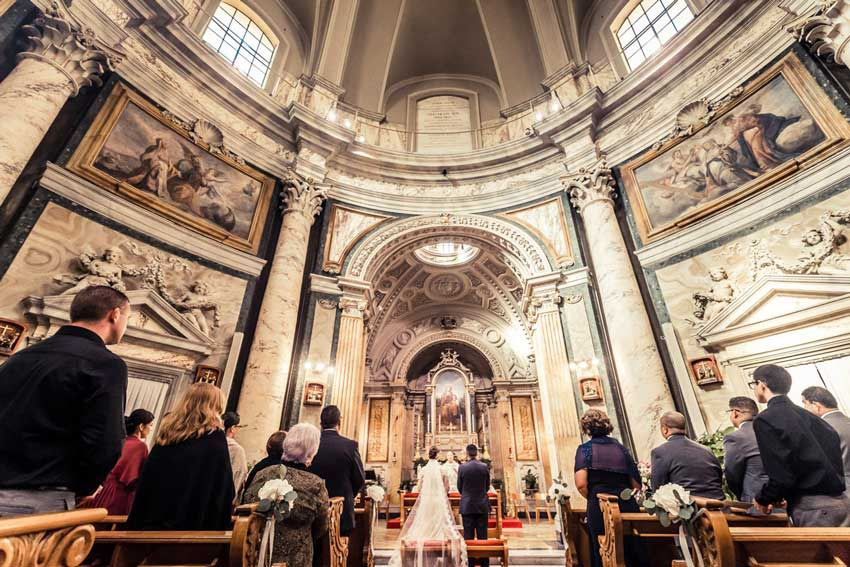
A Catholic wedding isn’t just one of the biggest commitments that two people can make in their life; it is also considered to be one of the most important aspects of Catholic life. As one of the seven sacraments alongside Baptism, Confirmation, Holy Communion, Confession, Holy Orders, and the Anointing of the Sick; Marriage is a rite that’s rich with symbolism, and full of deep meaningful spirituality.
Being one of the greatest expressions of love that two people could share for one another, a Catholic wedding binds a man and woman together in the eyes of the Lord, blessing them on their wedding day, and bringing friends and families together in celebration of two souls being bound by God.
Contents
Who Can Have a Catholic Wedding?
Well, Catholics of course. There is a big difference between having a traditional Catholic wedding performed by a priest in a Church, and one outside of the Church, or one that is officiated by someone who is not a member of the cloth.
In the past, traditional Catholic weddings were only reserved for couples who were both practicing members of the Catholic Church. Today, if one person is a practicing Catholic and the other person is of a different Christian faith, religious belief, or lack thereof; the couple is now permitted to have their wedding witnessed by a priest, in the Church, and outside of Mass.
Are There Any Restrictions That Could Prevent You from Having a Catholic Wedding?
There are a few restrictions or requirements that need to be taken into account before the Church could permit the marriage. If either partner is a divorcee, they need to have their first marriage annulled. Someone who has had a previous marriage that has been recognized by the Catholic Church, can not be remarried by the Church again.
Taking your wedding vows is not simply just a contract between you and your spouse. Wedding vows are a contract and promise made between you, your spouse, and God, and should never be taken lightly. The Church can not permit someone who has previously sworn themselves to a lifelong union with another, to be remarried to a new partner.
Never fear, however. If you or your partner have found yourselves to be an unfortunate divorcee, the Church does understand that sometimes a marriage can be considered invalid and needs to be annulled. This is not something the Church considers lightly. All marriages that have been annulled by the church, have managed to meet the requirements for invalidating the marriage.
Both parties also need to be sound of mind, and able to understand what they are committing themselves to. They also need to be participating out of their own free will, and not under coercion or out of fear.
Are all Weddings Performed in a Church, Catholic?
No, not every wedding performed within a Catholic Church is automatically consider a Catholic wedding. Many non-Catholics and non-religious people can have their weddings witnessed by a priest, marriage officiant, or celebrant, within the walls of a Catholic Church.
A Catholic wedding must be witnessed by a Catholic priest, and the couple needs to be knowingly, and willingly, to commit themselves to a lifetime union with their partner, while living out their lives in accordance with the laws and teachings of Jesus Christ, and the Catholic Church. If either of these conditions are not met, then the marriage can not be recognized as being valid in the eyes of the Church.
There are many reasons why non-Catholic wedding ceremonies are performed inside of some Catholic Churches, or even witnessed by a Catholic priest. This could be due to the lack of any other appropriate Churches, venues, or services in the area. Or simply out of tradition, or because this is what they have been taught to be the correct way to be married.
For the Catholic Church and members of the clergy, they serve God and work to help spread the teachings and guidance of Jesus Christ to their fellow man. By providing this crucial service to people of all walks of life, they are able to help better the lives of others and influence the hearts and minds of these people in the process.
Who Can Conduct the Wedding Ceremony?
Depending on where you live, and who you are in relation to within the local community, the parish itself, or the Church as a whole, there are three different religious figures that can perform your wedding ceremony and witness the validation of your union.
The majority of people will have their wedding ceremony performed for them by either a priest or a deacon. If you live in a large metropolitan area, more than likely, it may be a deacon who witnesses your marriage. In smaller areas, where the parish may have fewer members, there may only be a solitary priest who will oversee all ceremonies and sacraments.
Then there are the lucky few, who thanks to political pull, relationship, or social standings, can find themselves having their wedding ceremony being conducted by the Bishop of their diocese.
In truth, all members of the Catholic clergy are capable of performing the sacrament of marriage. From the most humble of deacons, right up to the very pope himself, all of our holy leaders are able to witness the union of two souls in holy matrimony.
Catholic Wedding Traditions
Weddings can be conducted as part of a Mass service, known as a Nuptial Mass, or privately outside of Mass. Depending on who you are marrying, where you live, the cultural background of your upbringing, and the structure of your local community; the wedding ceremony you could experience can be different from that of another Catholic.
Cultural Differences
When most people think of “cultural differences”, they tend to think of racial culture differences. This could be the furthest from the truth. Cultural differences can mean anything relating to geographical, geopolitical, accessibility, and yes, even racially orientated differences.
Regardless of who you are, where you are from, the color of your skin or the language you speak, Catholics from all over the world are still Catholic.
In the US, grooms tend to wear a full suited tuxedo for their wedding ceremony. Yet in countries like Scottland, the groom may sport their family colors by donning on a kilt instead of a pair of tuxedo pants.
What about traditions where the groom is not allowed to see the bride before their wedding and needs to wait for her at the altar. The first time he gets to see her is when she is being walked down the aisle by her father.
Yet there are also other customs where both the bride and groom are walked down the aisle by their parents. They may both be seen seated at a kneeling bench at the front of the church, waiting for the guests to arrive before they can start the ceremony. Or they could both be found standing at the door of the church, greeting and thanking everyone as they arrive.
Even when a veil (Lazo) and cord is placed over the bride and groom, or their hands are bound by a lasso rosary bead, or both of the family’s ancestors are being honored and paid respect; all of these different cultural practices are still acceptable Catholic traditions. They are just more traditional for different people in different parts of the world.
Rehearsals Are Important
Due to the different traditions that can be found across the world, it is vital that you first speak with your priest about the ceremony that they are going to perform, and how. They can inform you of how the ceremony will proceed. What roles you, your partner, or your parents may be required to perform, such as greeting your guests personally, if you will be required to kneel at the alter, or stand before the priest.
A Catholic wedding is also a very inclusive ceremony. Your non-Catholic friends are more than welcome to share the day with you and your future Husband/Wife. They can even be your best man or maid of honor, but just how much they are allowed to participate in the ceremony, may vary from Church to Church, or priest to priest.
So it is highly advisable for all participants to attend the wedding rehearsals. Everyone needs to be fully aware of the responsibilities, and the duties of the role that they’ll be playing during your wedding ceremony.
Having a Nuptial Mass Wedding Ceremony
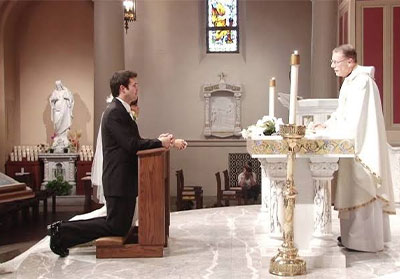
Having your wedding during Mass is more limiting in the way of customization. For some Catholics, having a wedding during a Nuptial Mass is more important than having the perfect fairytale wedding, that has been scripted to match their dreams, or to look like a scene from their favorite movie.
The biggest difference between having a Nuptial Mass wedding ceremony, or a non-Mass wedding ceremony, has to do with the manner in which the ceremony is performed.
A Nuptial Mass wedding ceremony has the readings from Scripture, and the celebration of Eucharist, incorporated into the ceremony itself. The only customization that can be applied to the ceremony, has to do with the Scripture readings and the Hymns that are sung by the guests. Under the guidance of the priest, the bride and groom can choose which Scripture and Hymns may be included in their ceremony. The priest will advise them on the suitability of each of their choices, and which of the Scripture needs to be read by himself, and which ones can be read by the bride and groom’s important guests.
What Are the Nuptial Mass Wedding Ceremony Procedures?
Before the ceremony can begin the bride and groom will need to take their place before the altar, with their back to their guests. They may take a seat on chairs, or use a kneeling bench. The first few pews will be reserved for members of the bride and groom’s wedding party, their parents, and other important guests.
Most Nuptial Mass weddings are held when two practicing Catholics wish to be married. A Nuptial Wedding is more of an open event when compared to the more private non-Mass wedding ceremony. At many ceremonies, all members of the parish are welcomed to attend the wedding, even if they do not know the bride or groom personally.
The ceremony proceeds as follows:
- The Entrance Rite
- The Scripture Readings
- The Rite of Marriage
- Liturgy of the Eucharist
- Communion Rite
- Concluding Rite
For more information please have a read of our article on Nuptial Mass Weddings.
Having a Wedding Ceremony Service Outside of Mass
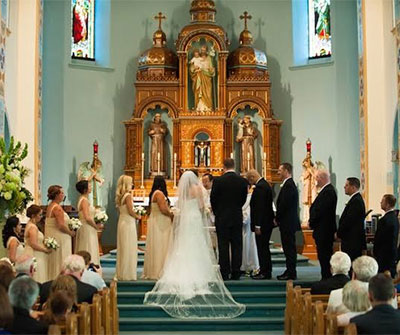
The other form of a Catholic wedding ceremony is held outside of Mass. What makes a non-Mass wedding ceremony different from a Nuptial Mass ceremony, is the absence of the Eucharist, the flexibility in which social customs can be included in the ceremony, and how the bride and groom are often joined at the front of the church by their wedding party.
Non-Mass wedding ceremonies also tend to be more private affairs, with a large majority of the guests that are in attendance, being personally invited by the bride and groom.
What Customs Are Allowed?
There are many different customs that could require the bride and groom to greet their guests in the church before the ceremony begins, or to have both or either of them enter the church after all of their guests have been seated.
You will need to speak with your priest about which process you wish to use for the arrival of your guests, the wedding party (the groom’s men and bride’s maids), the groom and the bride. You should also enquire about which cultural or social customs can be included in the ceremony.
Sometimes there are customs that can not be included in the ceremony itself. But there can be allowances made for these customs to be taken place immediately prior to the ceremony, or as the new husband and wife make their way out of the church.
These customs could include, the playing of bagpipes, giving of gifts and trinkets, or dancing and music. For example, there may be an Asian good luck tradition or Irish dance that you want to include to honor your heritage or pay your respects to your elders.
Then there’s the lighting of a unity candle, pouring of sand into a vase, the use of improvised vows, or the giving of wedding coins, and placing flowers before the image of the Virgin Mary.
All of these customs will need to be run by your priest first. They may allow for some things to be done, or they may feel that other things could be inappropriate to be done inside of the church. Respect their decision and reserve these customs for the wedding reception, or perform them outside of the church itself.
The Wedding Ceremony
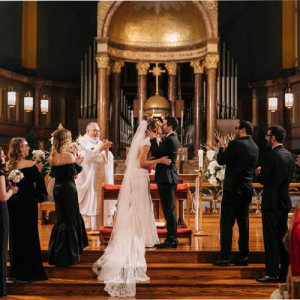
The actual ceremony itself, will not begin until all guests are seated, the bride and groom are standing before the priest, and the priest can command everyone’s attention. The more famous wedding song “Here Comes the Bride” that is often used to accompany the bride as she walks down the aisle, is not the start of the ceremony. That is yet another custom that is a personal choice and is not a requirement for the ceremony to commence.
The priest will use the first half of the ceremony to address and include everyone in attendance.
1) The Gathering Rite
Also known as The Entrance Rite, all guests stand and wait for the ceremony to commence. When the priest is able to hold everyone’s attention, they begin by addressing everyone in attendance.
- The priest begins welcoming the guests, and family members of the bride and groom.
- The purpose and significance of the ceremony is made clear to everyone, including the bride and groom.
- The first hymn of the ceremony is sung by the whole assembly.
- The priest will now invite everyone to join them in the opening prayer, before encouraging them to be seated.
2) The Liturgy of the Word
The priest will now lead the congregation in the readings from Scripture. What the priest reads aloud, may have been selected by the bride and groom, or by himself.
The First Reading
The priest will read Scripture from the Old Testament. At the conclusion of the reading, the priest proclaims “The word of the Lord” and those in attendance, respond with “Thanks be to God”.
Responsorial Psalm
If a choir is present, they will now lead the assembly in singing a psalm.
The Second Reading
The priest can read Scripture from a book of the New Testament. At the conclusion of the reading, the priest proclaims “The word of the Lord” and those in attendance, respond with “Thanks be to God”.
Gospel Acclamation
Everyone in attendance stands and sings the Gospel Acclamation. There are several options available for the hymn that is sung. Outside of Lent, the Alleluia is the more common choice for most weddings.
The Reading of the Gospel
The priest will now read of the Gospel for all to hear. At the conclusion of the reading, the priest proclaims “The Gospel of the Lord” and those in attendance, respond with “Praise to you, Lord Jesus Christ”, before taking their seats again.
Homily
The priest will offer their spiritual insight on matters of life, love, union, or the graces of the Lord, that relate to this particular wedding ceremony, or couple. While the inspiration of a Homily is drawn the Scripture readings themselves, a Homily is more of an educational sermon, rather than spiritual directions or instructions.
3) The Celebration of Matrimony
Now comes the part where the priest will focus all of their attention on the bride and groom themselves. To let everyone in attendance know that they are now going to be addressing the bride and groom directly, the priest will inform the assembly of this by saying something along the lines of:
“Dearly beloved, you have come together into the house of the Church so that in the presence of the Church’s minister and the community, your intention to enter into Marriage may be strengthened by the Lord with a sacred seal. Your love may be enriched with his blessing, so that you may have the strength to be faithful to each other forever and assume all the responsibilities of married life. And so, in the presence of the Church, I ask you to state your intentions.”
Confirmation of Intent
The priest questions the bride and groom to confirm that they truly wish to be married, are freely choosing to do so out of their own free will, and that they’ll agree upon the terms and conditions that come with being married.
“(Bride) and (Groom), have you come here to enter into Marriage without coercion, freely and wholeheartedly?”
Bride and Groom: “I have”
“Are you prepared, as you follow the path of Marriage, to love and to honor each other for as long as you both shall live?”
Bride and groom: “I am”
*“Are you prepared to accept children lovingly from God and to bring them up according to the law of Christ and his Church?”
Bride and Groom: “I am”
*The question pertaining to children may be omitted if the bride and groom are getting on in age. It can also be passed if the couple is aware that one of them may have fertility complications.
Consent
The final act of consent to the marriage is shown when the priest invites them to declare their consent:
“Since it is your intention to enter the covenant of Holy Matrimony, join your right hands, and declare your consent before God and his Church.”
The Bride and Groom will now join their right hands.
Wedding Vows
There are several different ways in which the wedding vows can be exchanged. The priest may ask the bride and groom of their intentions, they may recite the vows to each other, or they may even use vows that they have written themselves. Here are some examples of what may be said:
Priest to the Groom:
“(Groom’s name), do you take (the Bride’s name) for your lawful wedded wife, to have and to hold, from this day forward, for better, for worse, for richer, for poorer, in sickness and in health, until death do you part?”
The Groom: “I do.”
Priest to the Bride:
“(Bride’s name), do you take (Groom’s name) for your lawful wedded husband, to have and to hold, from this day forward, for better, for worse, for richer, for poorer, in sickness and in health, until death do you part?”
The Bride: “I do.”
Groom to the Bride:
“I, (their name), take you, (the Bride’s name), for my lawful wife, to have and to hold, from this day forward, for better, for worse, for richer, for poorer, in sickness and in health, until death do us part.”
Bride to the Groom:
“I, (their name), take you, (the Groom’s name), for my lawful husband, to have and to hold, from this day forward, for better, for worse, for richer, for poorer, in sickness and in health, until death do us part.”
Written Their Own Vows:
“(Their partner’s name) ever since we first met (how they met), I knew that I wanted to spend the rest of my life with you, to grow old together, and start a family. I have been the one who (the effect that they have had on their lives, or the things that they love about them). I would be honored if you were to accept me as your lawful wedded (Husband/Wife).”
The Reception of Consent
Following the exchanging of vows, the priest will say something along the line of:
“May the Lord in his kindness strengthen the consent you have declared before the Church and graciously bring to fulfillment his blessings within you. What God has joined, let no one put asunder.
May the God of Abraham, the God of Isaac, the God of Jacob, the God who joined together our first parents in paradise, strength and bless in Christ the consent you have declared before the Church, so that what God joins together, no one may put asunder.”
Before inviting those in attendance to praise god:
“Let us bless the Lord.”
Those in assembly:
“Thanks be to God.”
The Blessing and Giving of the Rings
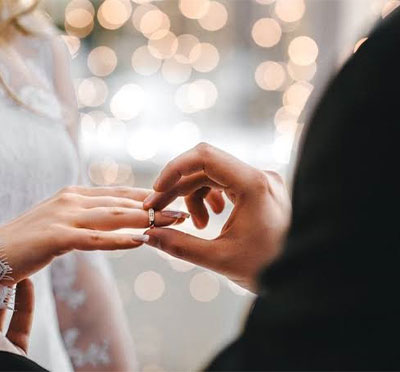
Before the rings are given over to the bride and groom, the priest will have them blessed by reciting a prayer similar to the following prayer:
Bless, O Lord, these rings
which we bless in your name.
so that those who wear them
may remain entirely faithful to each other,
abide in peace and in your will,
and live always in mutual charity.
Through Christ our Lord.Amen.
The priest might sprinkle the rings with holy water, before giving the first ring to the groom. The groom places the ring on his bride’s ring finger, and may say:
“(the Bride’s name), receive this ring as a sign of my love and fidelity. In the name of the Father, and of the Son, and of the Holy Spirit.”
The priest then hands the bride the other ring. The bride places the ring on her groom’s ring finger, repeating the same:
“(the Groom’s name), receive this ring as a sign of my love and fidelity. In the name of the Father, and of the Son, and of the Holy Spirit.”
4) Concluding Rite
With the rings exchanged, and their vows swore to one another, the bride and groom can now be declared, “Husband and Wife”.
Blessing
The priest will now recite a solemn blessing over the newly married couple, their families and friends, and anyone else who may be present. Everyone present will participate in the blessing by repeatedly interjecting with an “Amen” in unison with one another.
Witnesses may be called to sign the marriage license in front of the assembly. This may be done to the side of the church, or in front of the altar, but never upon it.
Dismissal
The assembly will be dismissed by the priest, who will offer a humble blessing of:
“Go in peace to glorify the Lord with your life.”
Everyone in attendance: “Thanks be to God.”
Recessional
With the license signed, the priest may seal the deal by saying:
“I now pronounce you, Husband and Wife, you may kiss the bride”
Thus concluding the wedding ceremony, as the newlyweds lead everyone out of the church. The couple is followed by their bridal party, the ministers, and the priest who conducted their wedding ceremony. The parents of the couple may also make their way outside before anyone else.
As the wedding progression makes their way out, there may be hymns sung by the choir, or festive and celebratory music may accompany them.
Wedding Reception
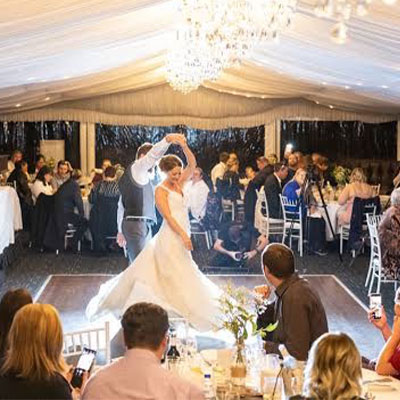
With the wedding ceremony over, the newlyweds may pose for photos, thank their guests, or pay their respects to their parents and grandparents. Most western culters conclude the day with a wedding reception.
This is an event where the close friends and family of the couple, will gather for a party in celebration of the occasion. There can be a lot of food, alcohol, and music and dancing at this event.
It’s a time for everyone to let their hair down, share stories with one another, and show their love and appreciation for the happy couple. The wedding reception is where we can see far more of the cultural differences that can be found in Catholics from all over the world.
Share this moment with your loved ones and enjoy yourself. You can be playful with your husband or wife when cutting the cake, you can spend the evening with friends and family that you don’t get to see that often. And it’s where you can have your first dance together as husband and wife.
Leave a Reply